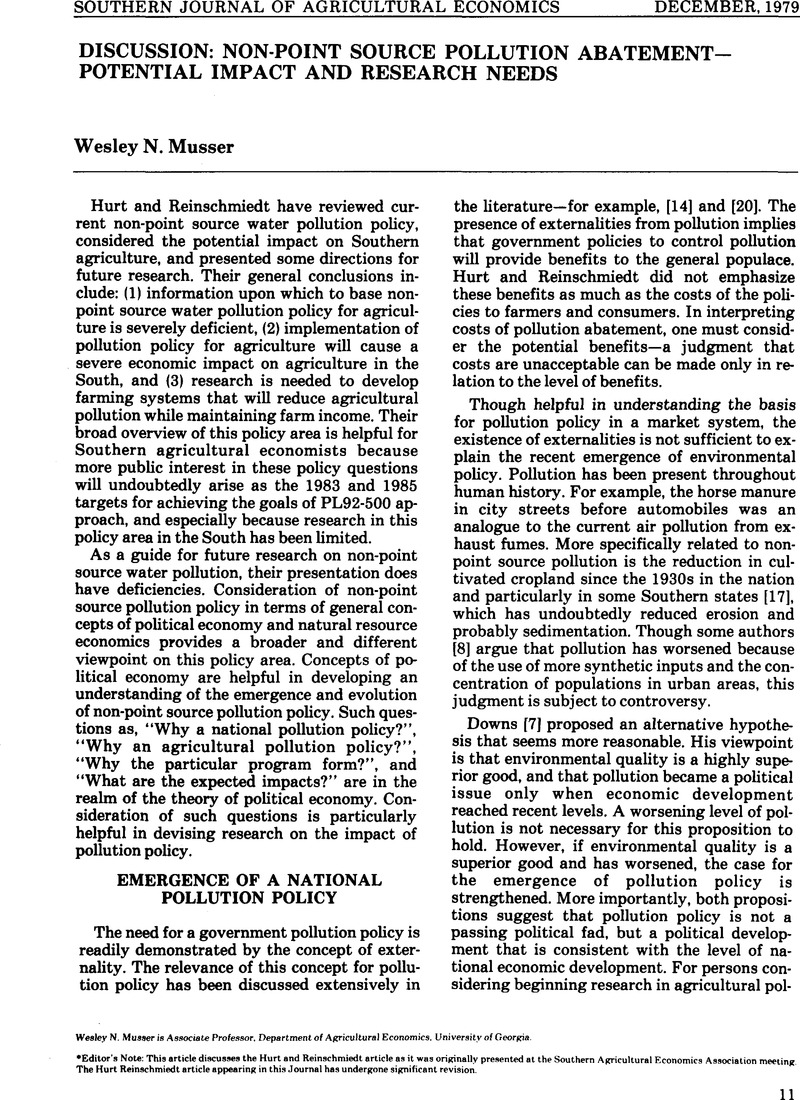No CrossRef data available.
Article contents
Discussion: Non-Point Source Pollution Abatement—Potential Impact and Research Needs
Published online by Cambridge University Press: 28 April 2015
Abstract
An abstract is not available for this content so a preview has been provided. Please use the Get access link above for information on how to access this content.

- Type
- Discussion
- Information
- Copyright
- Copyright © Southern Agricultural Economics Association 1979
References
[1]Barnett, Harold J. and Morse, Chandler. Scarcity and Growth. Baltimore: The John Hopkins University Press, 1963.Google Scholar
[2]Baumol, William J. and Oates, Wallace E.. “The Use of Standards and Prices for Protection of the Environment,” Swedish Journal of Economics, Volume 73, 1971, pp. 42–54.CrossRefGoogle Scholar
[3]Bonnen, James T. “Present and Prospective Policy Problems of U. S. Agriculture: As Viewed by an Economist,” Journal of Farm Economics, Volume 47, December 1965.CrossRefGoogle Scholar
[4]Braybrooke, David and Lindblom, Charles E.. Strategy of Decision. New York: The Free Press, 1963.Google Scholar
[5]Buchanan, James M. and Tullock, Gordon. “Polluters' Profits and Political Response: Direct Control Versus Taxes,” American Economic Review, Volume 65, March 1975, pp. 139–147.Google Scholar
[6]Davis, Velmar W.et al. Economic Consequences of Restricting the Use of Organochloride Insecticides on Cotton, Corn, Peanuts, and Tobacco, USDA, ERS, Agricultural Economics Report No. 178, March 1970.Google Scholar
[7]Downs, Anthony. “Political Economy of Improving Our Environment,” in Bain, Joe S., Environmental Decay. Boston: Little, Brown and Company, 1973.Google Scholar
[8]Ehrlich, Paul R. and Ehrlich, Anne H.. Population, Resources, Environment. San Francisco: W. H. Freeman and Company, 1970.Google Scholar
[9]Eichers, Theodore R., Andrilenas, Paul A., and Anderson, Thelma W.. Farmers' Use of Pesticides in 1976, USDA, ESCS, Agricultural Economics Report No. 418, December 1978.Google Scholar
[10]Freeman, A. Myrick III and Haveman, Robert H.. “Clean Rhetoric and Dirty Water,” The Public Interest, Number 28, Summer 1972.Google Scholar
[11]Fuller, Varden. “A New Era for Farm Labor,” Industrial Relations, Volume 6, May 1967.CrossRefGoogle Scholar
[12]Hathaway, Dale E. “Agriculture's Changing Political Power,” Co-op Grain Quarterly, Volume 26, June 1968.Google Scholar
[13]Horner, Gerald L. “Internalizing Agricultural Nitrogen Pollution Externalities: A Case Study,” American Journal of Agricultural Economics, Volume 57, 1975, pp. 346–354.CrossRefGoogle Scholar
[14]Langham, Max R., “A Theoretical Framework for Viewing Pollution Problems,” Southern Journal of Agricultural Economics, Volume 3, December 1971, pp. 1–8.Google Scholar
[15]Moffitt, L. Joe, Zilberman, David, and Just, Richard E.. “A ‘Putty-Clay’ Approach to Aggregation of Production/Pollution Possibilities: An Application in Dairy Waste Control,” American Journal of Agricultural Economics, Volume 60, 1978, pp. 452–459.CrossRefGoogle Scholar
[16]Musser, Wesley N. “Federal Manpower Policy and the Rural Sector,” unpublished Ph.D. dissertation, University of California, Berkeley, 1974.Google Scholar
[17]Musser, Wesley N., Oosthuizen, Johannes, and White, Fred C.. Corn Production in Georgia, Georgia Agricultural Experiment Station Research Report, in preparation.Google Scholar
[18]Nix, James E., Martin, Neil R. Jr., and Hubbard, John W.. “An Enterprise Competition Analysis of Beef Production in the South,” Southern Journal of Agricultural Economics, Volume 7, December 1975, pp. 95–104.Google Scholar
[19]Osteen, Craig and Seitz, Wesley D.. “Regional Economic Impacts of Policies to Control Erosion and Sedimentation in Illinois and Other Corn Belt States,” American Journal of Agricultural Economics, Volume 60, 1978, pp. 510–517.CrossRefGoogle Scholar
[20]Paarlberg, Don. “Agricultural Programs in the Seventies: The Political-Economic Environment” Southern Journal of Agricultural Economics, Volume 5, July 1973, pp. 17–21.Google Scholar
[21]Randall, Alan. “Market Solutions to Externality Problems: Theory and Practice,” American Journal of Agricultural Economics, Volume 54, 1972, pp. 175–183.CrossRefGoogle Scholar
[22]Schultze, Charles L.The Politics and Economics of Public Spending. Washington, D.C.: The Brookings Institution, 1968.Google Scholar
[23]Sharpies, Jerry A. “The Representative Farm Approach to Estimation of Supply Response,” American Journal of Agricultural Economics, Volume 51, May 1969, pp. 353–360.CrossRefGoogle Scholar
[24]Smathers, Webb M. Jr.et al. “A Small Farm Model's Role as a Precursor to a River Basin Pollution Model,” Department of Agricultural Economics, University of Georgia, unpublished paper, 1978.Google Scholar
[25]Taylor, C. Robert and Frohberg, Klaus K.. “The Welfare Effects of Erosion Controls, Banning Pesticides, and Limiting Fertilizer Applications in the Corn Belt,” American Journal of Agricultural Economics, Volume 59, 1977, pp. 25–35.CrossRefGoogle Scholar
[26]Touchton, J. T. and Cummins, D. G., editors. Proceedings of the First Annual Southeastern No-Till Systems Conference, Georgia Agricultural Experiment Station Special Publication No. 5, November 1978.Google Scholar
[27]White, Fred C.et al. The Environmental and Economic Impact of Placing Soil Bank, Marginal, and Submarginal Land in Crop Production in Georgia, Final Report of EPA Grant R804510, in preparation.Google Scholar
[28]Wise, James O. and Saunders, Fred B.. Maximizing Operator's Returns on Large Commercial Farms in Beef Producing Areas of the South, Southern Cooperative Series, Bulletin No. 217, June 1977.Google Scholar
[29]Zwick, David R. “A Criticism of the Effluent Charge,” in Enthoven, Alain C. and Freeman, A. Myrick III, editors, Pollution, Resources, and the Environment. New York: W. W. Norton and Company, Inc., 1973.Google Scholar




